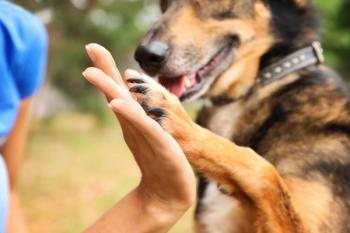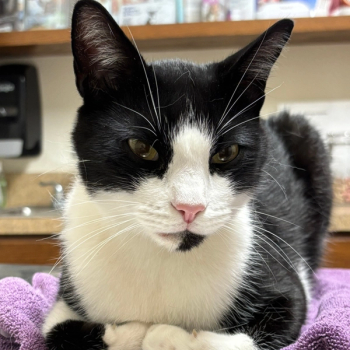
Recognizing 3 eye emergencies
A veterinary ophthalmologist discusses when ocular conditions turn urgent during the Midwest Veterinary Conference
Some severe eye injuries or disease can appear to worsen drastically and need immediate attention. Ralph E Hamor, DVM, MS, DACVO, Hamor Veterinary Ophthamology LLC, explained to attendees at the 2024 Midwest Veterinary Conference,1 about what makes an eye condition an emergency. “Ocular emergencies. I was laughing with a colleague at lunch because I don’t know why I lecture on these because I don’t really think they exist,” Hamor confessed to attendees. “There aren’t too many of them. [Patients] usually aren’t going to die with [ocular issues].”
Hamor then explained that ocular issues don’t usually require dire emergency attention, but they can still be urgent and need to be treated swiftly. He first noted that ocular emergencies can often look similar, so he categorized different cases with its respective clinical presentation.
- Acute eye pain could be corneal ulcers, glaucoma, anterior lens luxation, or anterior uveitis.
- Red eye could be glaucoma, orbital disease, uveitis, conjunctivitis, or keratitis.
- Cloudy eye could be glaucoma, anterior lens luxation, or anterior uveitis.
- Bulging/swollen eye could be glaucoma, buphthalmos, or exophthalmos.
- Acute blindness could be glaucoma, retinal disease, or sudden acquired retinal degeneration syndrome.
Glaucoma can present as all 5 of these categories, so this is just one example of how it can be challenging to get the diagnosis correctly.
Proptosis
One ocular emergency is proptosis, a bulging of the eye out of the socket usually caused by injury, like blunt trauma (such as being hit by a car or attacked by another animal). This injury dislodges the eyeball from the orbit and eyelid spasms prevent the eyeball from returning to its proper position. As bleeding and swelling occur, the eye is displaced more extensively from its socket. This results in dryness of the eye, potentially leading to a deterioration or loss of vision.2
Hamor stated that a few indicators can determine the prognosis of this particular ocular emergency. If the patient appears to have full or partial vision or a normal pupillary light reflex, then prognosis is usually better. However, if the patient has damage to more than 3 extraocular muscles, hymphema, or a desiccated cornea, then the prognosis would be worse. Hamor did mention that counting extraocular muscles in general is difficult, so checking for damaged ones would be even more challenging.
Because of the injury's traumatic nature, most dogs do not regain vision, but brachycephalic dog breeds have a 30% chance at regaining vision, according to Hamor. “Basically, some brachycephalics can regain vision. They have a very swallow orbit. They have a very wide eyelid opening. Their eyeballs fall out on a random Tuesday,” Hamor joked.
Corneal ulcers
Corneal ulcers may arise due to insufficient eye lubrication (inadequate tear production) or as a result of trauma, such as scratches or other injuries.2 Corneal injuries can also occur from a foreign object getting caught in the eye like dirt, sand, an eyelash, wood shavings, etc. The ulcers can escalate in severity if infections take hold.
Hamor would classify a deep ulcer as an ocular emergency. These cases should warrant getting a culture and cytology report. Hamor recommended getting a Schirmer tear test in the unaffected eye, since the injured eye will most likely come back inaccurate.
Glaucoma
Identified by elevated pressure within the eye, glaucoma has the potential to result in vision loss.2 This is primary and secondary glaucoma. In primary glaucoma cases, it typically occurs in middle aged dogs and the drainage is not working properly because of breed dispositions or genetics. “[Primary glaucoma] is the one of the most frustrating diseases in veterinary ophthalmology to treat. I’ve been doing it for years and I keep thinking that something is going to change my life and save vision,” Hamor said. “With primary glaucoma, I usually tell owners: vision battle is a war. [Unfortunately], we’re going to lose the war so it’s more so about how many battles do you want to fight and how much money are you willing to spend?” Hamor stated that primary glaucoma can be stalled so it could be worth it for some owners to try treatment.
In secondary glaucoma, the drainage structure has been affected by some outside force like trauma or other disease. According to Hamor, secondary glaucoma tends to have a better outcome than primary. Secondary could be solved with treatment, unlike primary.
Although not every eye injury or disease will be an emergency, it is important to help inform clients about the signs and symptoms of cases that can worse if left untreated. Treating any urgent ocular case quickly can help prevent prolonged pain, infection, and vision loss.
References
- Hamor R. Ocular emergencies: What can I do? Presented at: Midwest Veterinary Conference; February 20-22, 2024.
- Gelatt K. Eye emergencies. Merck Veterinary Manual. November 2022. Accessed February 27, 2024.
https://www.merckvetmanual.com/special-pet-topics/emergencies/eye-emergencies
Newsletter
From exam room tips to practice management insights, get trusted veterinary news delivered straight to your inbox—subscribe to dvm360.





